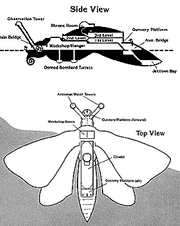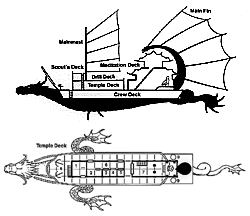Spelljamming, the use of spelljammer vessels for the exploration of wildspace and other worlds of the Prime Material plane, was practiced by multiple peoples in several nations throughout the history of Toril.[1][2][note 1]
Geography
The world of Toril was but one of several other worlds[3] in the Realmspace crystal sphere. To the natives of Faerûn, the wildspace above their heads was known as the Sea of Night.[4] The two closest worlds to the sun in the middle of Realmspace were known as the Dawn Heralds, and were barely visible only at sunset or sunrise. Beyond Toril further out in the crystal sphere were the Five Wanderers, five worlds which flowed through star-rivers in an uneven course through wildspace. Some of these worlds were inhabited by humans, dwarves, and orcs, but also more sinister races such as illithids and beholders.[1]
History
It was said that in the beginning Ao created a crystal sphere called the Sea of Night, which he created from the raw material of the phlogiston, the material between crystal spheres.[5] Within this realm drifted several lifeless worlds, and it was from the remains of this creation process that two twin beings formed, one of dark (Shar) and one of light (Selûne). These two beings set in motion a series of events that resulted in life on these barren worlds.

Monarch-class armada spelljammer ship.
Exactly when the natives of Toril themselves began to traverse wildspace was unknown, though it dated back to at least the era of Cormanthyr. The elves had always been known to have a strong presence in wildspace.[citation needed]
Miirphys Irithyl (reign -1338 DR to -791 DR), an early coronal of the elven nation of Cormanthyr, was a supporter of the elven high mages' desire to launch more spelljammer ships.[6] The High Magic elaorman ritual was often used in the construction of the elven crystalline spelljammer ships, and was a requirement in the construction of the monarch spelljammer ships.[7]
The reason that the elven high mages were so keen on creating more spelljammer ships was in order to counter the Netherese expansion into wildspace. The Netherese had been dabbling and exploring Realmspace for a while. The elves suspected that the Netherese discovered the magic of spelljamming as early as -1114 DR,[8] though in truth it was much earlier since the epic spell Proctiv's breach crystal sphere was created in 1808 NY (-2051 DR).
The Netheril mage Oberon (2839–2905 NY) was said to be the founder of Netheril's spelljammer industry, the "Father of Realmspace"[9] (or so his followers claimed at least). Oberon was born into the shipbuilding industry, his father having been a shipbuilder before him, and he dutifully followed in his father's footsteps. Unlike him, though, he imbued his vessels with magic, and it was claimed that he led the other mages of Netheril into building spelljamming vessels.
It really wasn't until 2795 NY (-1064 DR) that the Netherese officially launched themselves into wildspace with serious intent.[2] They found it to be an abundant source of wealth. The city of Yeoman's Loft became the center of Netheril's Realmspace activities.[10]
However, the Netherese also found the expense of maintaining the docking stations and spelljammer ships too high and the danger too great, and they stopped all spelljamming activity in 2895 NY (-964 DR).[2] The Elven Imperial Navy, a conglomeration of elven interests in space, much bigger in scope than just Cormanthyr's spacefaring, was said to have constantly harried the Netherese as well.[8]
Fan art of a man-o-war spelljammer.
During the Weeping War in 714 DR, a series of short battles became known as the "Three Greenwing Wars" by the elves—named as such for their ally an elven man-o-war ship.[11] The Elven Imperial Fleet of Realmspace sent the Monarch Mordent, a green-winged man-o-war spelljammer vessel captained by Oncith Ilbenalu. The Monarch Mordent provided heavy artillery and a crack crew of archers, bards, and wizards, which aided to briefly turn the tide of war in the northern forest. The ship fell in the last battle into the tree canopy below it. Its crystalline and photosynthetic wings continued to grow, however, and a large web of thin crystal grew to wrap around that part of the forest in what was later called the Monarchs Fall glade.[citation needed]
Pre-Spellplague
In the time shortly before the Spellplague hit, the elves of Evermeet were said to have a half-dozen spelljammer ships hidden in the Sumbrar fortress.[12] The Starwing (Ruathimaer) ships that Evermeet employed were similar to the traditional elven man-o-war spelljammer vessels.

However, the real spelljammer powers on Toril were in Kara-Tur. Both the nation of Shou Lung and Wa were active in spelljamming,[1] making Kara-tur the most visited area by spelljamming traders. These nations were also known for creating very unique (and in some cases incredibly large and powerful) spelljamming ships.
Post-Spellplague
Around the time of 1479 DR, it was unclear which nations still possessed Spelljammer vessels.
Post-Second Sundering
After the Second Sundering, a few rare mind flayer colonies still had their spelljamming vessels (the nautiloids), but had lost the secrets of manufacturing them. They kept their existence hidden and only used their ships in case of emergency, in fear of being detected by gith hunting parties.[13]
Appendix
Further Reading
2nd Edition D&D
- Steven E. Schend (January 1997). Undermountain: Stardock. Edited by Bill Olmesdahl. (TSR, Inc.), p. All. ISBN 0-7869-0451-8.
Web Material, 2nd Edition D&D
- Forgotten Realms Accessory: Gold & Glory mentions Code Helm, Emerald Brotherhood, The Enforcers and The Gauntlet. Four mercenary groups found in Realmspace. (This is a downloadable version of the Gold & Glory sourcebook. The groups are described on page 26.)
- Dungeon Crawl: Undermountain--Stardock is an adventure that starts in the tunnels below Waterdeep and then takes the players through a portal to one of the Tears of Selûne called Stardock.
Notes
- ↑ Spelljammer is a D&D campaign setting that mixes fantasy elements (elves, dwarves, ships, catapults, magic, and the like) in a space setting. Officially cancelled in 1993, some material for 3rd Edition was created at the Spelljammer web page.
References
- ↑ 1.0 1.1 1.2 Dale "slade" Henson (April 1991). Realmspace. Edited by Gary L. Thomas, Karen S. Boomgarden. (TSR, Inc). ISBN 1-56076-052-4.
- ↑ 2.0 2.1 2.2 slade, Jim Butler (October 1996). “The Winds of Netheril”. In Jim Butler ed. Netheril: Empire of Magic (TSR, Inc.), p. 93. ISBN 0-7869-0437-2.
- ↑ Ed Greenwood, Sean K. Reynolds, Skip Williams, Rob Heinsoo (June 2001). Forgotten Realms Campaign Setting 3rd edition. (Wizards of the Coast), p. 231. ISBN 0-7869-1836-5.
- ↑ Ed Greenwood, Sean K. Reynolds, Skip Williams, Rob Heinsoo (June 2001). Forgotten Realms Campaign Setting 3rd edition. (Wizards of the Coast), p. 230. ISBN 0-7869-1836-5.
- ↑ Bruce R. Cordell, Ed Greenwood, Chris Sims (August 2008). Forgotten Realms Campaign Guide. Edited by Jennifer Clarke Wilkes, et al. (Wizards of the Coast), pp. 41–42. ISBN 978-0-7869-4924-3.
- ↑ Steven E. Schend and Kevin Melka (1998). Cormanthyr: Empire of the Elves. (TSR, Inc), p. 46. ISBN 0-7069-0761-4.
- ↑ Steven E. Schend and Kevin Melka (1998). Cormanthyr: Empire of the Elves. (TSR, Inc), pp. 136–137. ISBN 0-7069-0761-4.
- ↑ 8.0 8.1 Steven E. Schend and Kevin Melka (1998). Cormanthyr: Empire of the Elves. (TSR, Inc), p. 35. ISBN 0-7069-0761-4.
- ↑ slade (1996). How the Mighty Are Fallen. (TSR, Inc), p. 12. ISBN 0-7869-0537-9.
- ↑ slade (1996). How the Mighty Are Fallen. (TSR, Inc), p. 3. ISBN 0-7869-0537-9.
- ↑ Steven E. Schend (1998). The Fall of Myth Drannor. Edited by Cindi Rice, Dale Donovan. (TSR, Inc.), p. 29. ISBN 0-7869-1235-9.
- ↑ Template:Cite book/The Elves of Evermeet
- ↑ Mike Mearls, et al. (November 2016). Volo's Guide to Monsters. Edited by Jeremy Crawford, et al. (Wizards of the Coast), p. 78. ISBN 978-0786966011.
